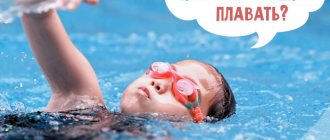Basics of proper swimming in various styles
Regardless of the age at which the skill is mastered, it is important to know: the correct body position is horizontal with the face lowered into the water . It is instinctive for a person to raise his head. But a lowered face helps maintain balance and prevents the cervical vertebrae from overworking during prolonged exposure to water.
This position increases buoyancy and increases speed in any style. Therefore, when you learn “from scratch”, it is better to immediately develop the correct position, so as not to waste time and effort on relearning.
Sports swimming has 4 styles:
- Butterfly . This style is not suitable for children who are just learning. It requires great physical effort and well-functioning coordination of actions. During the movement, the swimmer “flies” over the water, making simultaneous swings of his arms and a splash of his legs, similar to the movements of a dolphin.
- Breaststroke. The arms perform wide, “spreading” movements, and the legs seem to push off from the surface of the water.
- Crawl on the chest. The fastest style: the arms make sweeping strokes, and the legs perform alternating scissor-type swings. Most of the time the swimmer's face is submerged in the water. In this case, inhalation occurs while turning the head.
- Back crawl. The movements are identical to the previous style, only the swimmer is on his back. This is a clear advantage for children who are not comfortable putting their face in the water.
If you are not raising a professional athlete, you should not immediately accustom him to a particular style. First of all, you need to practice breathing, leg and arm work.
How to overcome your fear of water?
If a student is afraid of water, you should not convince him otherwise. To achieve quick results, it is important that classes take place in a comfortable and safe environment. Parents should focus not on overcoming fear, but on creating a feeling of safety. You can do this as follows:
- give the opportunity to get used to the water. When the baby looks around and is not distracted by new sensations, it is worth talking about the properties of water. In age-appropriate language, tell them that water, if the body is positioned correctly, will keep it afloat and “push” it to the surface. Show that the ball does not sink in water, explain why this happens. The absence of fear will allow you to achieve the desired result faster;
- let you feel the ground under your feet. Do not rush to immediately take the student into depth. The water level to the chest is optimal in the first stages of training. Invite the future swimmer to play games. The “Fountain” exercise helps you get comfortable in the water: bend your knees slightly so that your lips are in the water. In this position, you should blow out air with your mouth until bubbles form. This activity will certainly entertain the child and help cope with anxiety. In the future, you can go to a depth where the water level reaches the collarbones.
When teaching, it is important to remain calm, not to rush the child, and not to raise your voice. A parent should be a “lifeline”, a “guide” on the path to the unknown. When the fear of water is left behind, they begin to learn to stay afloat. You shouldn’t delay this moment, because you get used to being in the water, touching the bottom.
Stay calm and be a confident guide for your child, not only in learning to swim, but in any other situation. Always know where your child is and what is happening around him so that you can provide him with timely help or support. Download the “Where are my children” application from the AppStore and GooglePlay stores.





